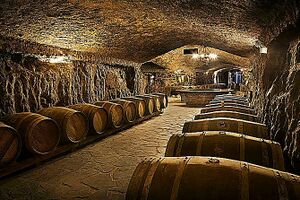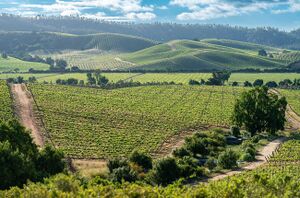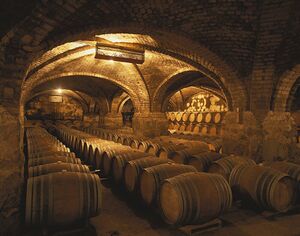Acirian wine: Difference between revisions
m Text replacement - "Category:Aciria" to "Category:Aciria {{AbandonLore}}" |
mNo edit summary |
||
| Line 1: | Line 1: | ||
{{NonCanon}} | |||
[[File:Wine cellar.jpg|thumb|right|A traditional wine cellar in a Valariano vineyard.]] | [[File:Wine cellar.jpg|thumb|right|A traditional wine cellar in a Valariano vineyard.]] | ||
[[Aciria]] has a long history of winemaking. The warm weather paired with the vast flatlands of Valariano and protective valleys in the Montanaro region located in southern Valariano and Santa Beatrice have enabled Acirian wine production since at least 3000 BC. The wines produced today are mainly expensive luxury wines meant for export to foreign markets, but many more affordable wines are also produced for domestic Acirian markets. Due to the long history of wine and its close association with Acirian history, culture and people, the drink is seen as inseparable from the national identity of Aciria. | [[Aciria]] has a long history of winemaking. The warm weather paired with the vast flatlands of Valariano and protective valleys in the Montanaro region located in southern Valariano and Santa Beatrice have enabled Acirian wine production since at least 3000 BC. The wines produced today are mainly expensive luxury wines meant for export to foreign markets, but many more affordable wines are also produced for domestic Acirian markets. Due to the long history of wine and its close association with Acirian history, culture and people, the drink is seen as inseparable from the national identity of Aciria. | ||
| Line 25: | Line 26: | ||
In the second half of the 20th century Montanaro vintners have established vineyards in the Kingdom of Malatra due to their mountainous southern areas, creating a more affordable, drier version of the renowned Montanaro wine. | In the second half of the 20th century Montanaro vintners have established vineyards in the Kingdom of Malatra due to their mountainous southern areas, creating a more affordable, drier version of the renowned Montanaro wine. | ||
[[Category: | [[Category:Daxia]] | ||
[[Category:IXWB]] | |||
Latest revision as of 10:54, 19 October 2023
This article is non-canonical either because it refers to out-of-character content, the associated nations have left the region, or the information has been retconned. Accordingly, its content should not be considered to be part of the canonical structure of the region's lore.
|

Aciria has a long history of winemaking. The warm weather paired with the vast flatlands of Valariano and protective valleys in the Montanaro region located in southern Valariano and Santa Beatrice have enabled Acirian wine production since at least 3000 BC. The wines produced today are mainly expensive luxury wines meant for export to foreign markets, but many more affordable wines are also produced for domestic Acirian markets. Due to the long history of wine and its close association with Acirian history, culture and people, the drink is seen as inseparable from the national identity of Aciria.
History
The viticulture of Aciria finds its roots in when ancient Acirianis found out that leaving wild grape juice in Amaro pots turned into wine when buried in a pit over the winter. The earliest and most widespread examples of this are in Valariano, where the practice slowly spread over time across all of modern day Aciria. Even after the development of sophisticated viticulture, the Amaro pots were still used for a long time as a mean of transporting the wine over longer distances. By the time of the Three Sisters, the region of modern day Valariano was known for its vineyards. The earliest established vineyard in the foothills of the Montanaro region, near Chegallari. Historical sources comparing Valariano wine to the Montanaro wine note that Montanaro wine is sweeter than its Valariano counterpart, inspiring other regions of Aciria to establish vineyards of their own, even if on a smaller scale than in Valariano. Due to the differences in climate of the Aciriano regions, the wines are described as "maritime", "continental" or "Montanaro" to differentiate between different wine types of Aciria.
Following the foundation of the Kingdoms of Pantevenna and Aciria, viticulture both spread and developed faster than before due to the stability a central authority ruling over the areas brought. The development and spread also brought down the price of wine, bringing the drink of the elite to the commoners for the first time in history. Generally, however, the wine of the commoners was the wine that was deemed subpar by the vintners and thus not suitable for serving to the nobles or kings. Kings often were buried with Amaro vessels filled with the favourite wine of the ruler, and robbing these graves became a lucrative business for graverobbers as nobles were willing to pay large sums to drink the wine that was buried with kings.

The winemaking of Aciria slowly declined from the 14th century onwards as Caphiria economic influence soared in the region, with Caphirian wine seen as more prestigious by the upper classes of society. Domestic wine wasn't as lucrative as before, with many historical vineyards shutting down due to financial troubles. The ones that survived were the ones that made most of their wealth from selling the lower class wines to commoners, as Caphirian wine wasn't affordable to the commoners the way it was to the nobles and royalty. Following the official annexation and integration of Aciria into Caphiria in 1430, the winemaking of Aciria declined further as Acirian winemaking was discouraged to further sell Caphirian wine.
The declaration and establishment of the Free Republic of Aciria meant a resurgence in domestic winemaking and consumption as the state wanted to distance themselves from their former overlord, they encouraged domestic wine by raising tariffs on foreign imported wine. The resurgence slowly fizzled out as the Free Republic collapsed into instability, with the true renaissance of domestic winemaking begins in the mid 19th century following the assimilation efforts and creation of a national Aciriani identity. The historical importance of wine and the skill of the historical winemakers was highlighted, with many vineyards reopening and being established with grants from the Imperial Seat.
Wine regions
The Ministry of Agriculture of Aciria officially details wine regions as "maritime", "continental" and "Montanaro", following the winemaking tradition of Aciria.
Maritime
The maritime wine region consists of Aciriani Marini, the Imperial Dominion of Montverde, Porto Nord and in the second half of the 20th century, Kingdom of Crasoa. The historical Aciriani Marini and Montverde are known for their white wines, with little red being produced for either Aciriani or foreign markets. The wines of the Maritime region are generally the cheapest both domestic and foreign markets, with Acirianis seeing the regions wine more fit for commoners despite often being praised in blind tastings over their more prestigious counterparts. Porto Nord's maritime wines often contain more alcohol (12 to 14%) than the other maritime wines (9 to 11%)
After the establishment of the Kingdom of Crasoa, some Aciriani vintners of the maritime school moved to the new Imperial Protectorate in an attempt to expand the maritime wine region and potentially use the unique climate of Crasoa to cultivate unique wines. The climate in Crasoa turned out to be too humid in much of the Kingdom, with only two of the original vintners successfully creating the Crasoan vineyards.
Continental
Continental wine region consists of Valariano, Santa Beatrice and the Kingdom of Malatra. The continental wine region has the longest history in winemaking in Aciria, with the vintners of the region priding themselves in their heritage. Continental wines are the ones that are most commonly both consumed domestically and exported to international markets, caused by both the large amounts of wineries and vineyards in the region and the vast flatlands that enable the viticulture. Continental wines are most often red, characterised as dry with floral aromas. Particularly the wine originating from Kingdom of Malatra is known for its dry nature.
Montanaro

By far the most valued wine region in Aciria is the Montanaro region, which geographically is a part of Valariano, Santa Beatrice and Kingdom of Malatra, but differentiated from the continental region due to the unique climate the mountainous region and its foothills offer to the vineyards of the region. Montanaro wines are the most expensive wines, caused by both the lack of vineyards in the region and the well-renowned flavour of the wine, generally only being available to international markets via direct orders from the vintners themselves. Montanaro wine is most commonly red, but white Montanaro isn't uncommon, with the characteristics of Montanaro wine being full-bodied, sweet, with hints of blackcurrant.
In the second half of the 20th century Montanaro vintners have established vineyards in the Kingdom of Malatra due to their mountainous southern areas, creating a more affordable, drier version of the renowned Montanaro wine.